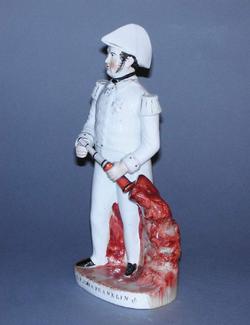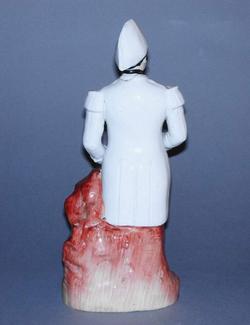Current Location: In storage
Titles
Sir John Franklin
Maker(s)
Production:
Alpha factory
(Perhaps)
Entities
Categories
Description
White earthenware figure moulded in three parts, with separately moulded telescope, and lead glazed. Painted with brown, black, orange, grey and flesh-pink enamels, and gilt. The underside is concave and glazed.
The oval base is inscribed ‘SIR JOHN FRANKLIN’, painted in partly-incised gilt capitals with three gilt strokes to either side. The figure is mainly white, with features picked out in enamels and gilt. Sir John stands in front of a brown painted rock, on brown painted ground. He wears uniform, with medals, epaulets, gold buttons and bicorne (or cocked) hat; his collar and shoes are black. He carries a telescope which is coloured orange and grey with black bands. The back is moulded, with a vent hole 9cm from the bottom.
Notes
History note: Mr Delves at Rye; bought as a pair with Lady Franklin, 14 November 1911 for 30 shillings, by Dr Glaisher, Trinity College, Cambridge.
Legal notes
Dr J.W.L.Glaisher Bequest
Measurements and weight
Depth: 8 cm
Depth: 3.125 in
Height: 27.5 cm
Height: 10.75 in
Width: 11.5 cm
Width: 4.5 in
Acquisition and important dates
Method of acquisition: Bequeathed
(1928)
by
Glaisher, J. W. L., Dr
Dating
19th Century, Mid
Victoria I
Production date:
circa
AD 1850
Note
An engraving in 'The Illustrated London News', 13 September 1851 shows Franklin in a similar pose and dress, save only that the telescope is reversed (reproduced in Pugh (1970), p.265, Plate 29).
Following Pugh (1970) and Balston (1958), it seems more likely that this figure was made by the ‘Alpha Factory’, an as yet unidentified producer whose figures share a number of common features. Here these include: well moulded in the round; a subsidiary moulding; and the title in partly incised capitals bracketed by three strokes of gilt.
In 1845, Sir John lead an expedition to discover the North West Passage, a route connecting the Atlantic and Pacific Oceans, passing through the Canadian Arctic archipelago, but did not return. After many search parties, several of which were funded by Lady Franklin, traces of ships and provisions were found, but no survivors. The expedition has inspired a wide variety of artistic works, including a ballad Lady Franklin’s Lament, c.1852. It is likely seems likely that this pair of figures was made at around the same time.
Rackham (1935) lists this figure as of a type made chiefly by Sampson Smith at Longton, a factory listed in contemporary directories as a ‘manufacturer of figures in great variety’, which began around 1851 and continued to make figures in quantity into the early part of the twentieth century. But Sampson Smith figures were rarely marked, and there were many other manufacturers of figures working in Staffordshire at this time.
This figure of the English naval commander and Arctic explorer Sir John Franklin (1786-1847) is the pair to a figure of Lady Jane Franklin. From 1837-43, Sir John was Lieutenant-Governor of Tasmania, from 1837-43, whilst Lady Franklin became an explorer and social pioneer of some renown.
School or Style
Victorian
People, subjects and objects depicted
Components of the work
Decoration
composed of
enamels
( brown, black, orange, grey and flesh-pink enamels)
gold
Materials used in production
White earthenware
Lead-glaze
Techniques used in production
Press moulding
: White earthenware moulded in three parts, with separately moulded telescope, and lead-glazed. Painted with brown, black, orange, grey and flesh-pink enamels, and gilt. The underside is concave and glazed. The back is moulded, with a vent hole 9cm from the bottom.
Painting
Lead-glazing
Gilding
Inscription or legends present
Inscription present: partly-incised gilt capitals with three gilt strokes to either side
- Text: SIR JOHN FRANKLIN
- Location: Front of base
- Method of creation: Painted in gold
- Type: Name
Inscription present: rectangular paper label
- Text: No. 3421. Staffordshire figure of Sir John Franklin (polar explorer) – circa 1850 – b. at Rye, Nov 14, 1911
- Location: Underside of base
- Method of creation: Hand-written in black ink
- Type: Label
References and bibliographic entries
Identification numbers
Accession number: C.1023A-1928
Primary reference Number: 71185
Old object number: 3421
Stable URI
Audit data
Created: Saturday 6 August 2011
Updated: Tuesday 30 April 2024
Last processed: Thursday 14 August 2025
Associated departments & institutions
Owner or interested party:
The Fitzwilliam Museum
Associated department:
Applied Arts






